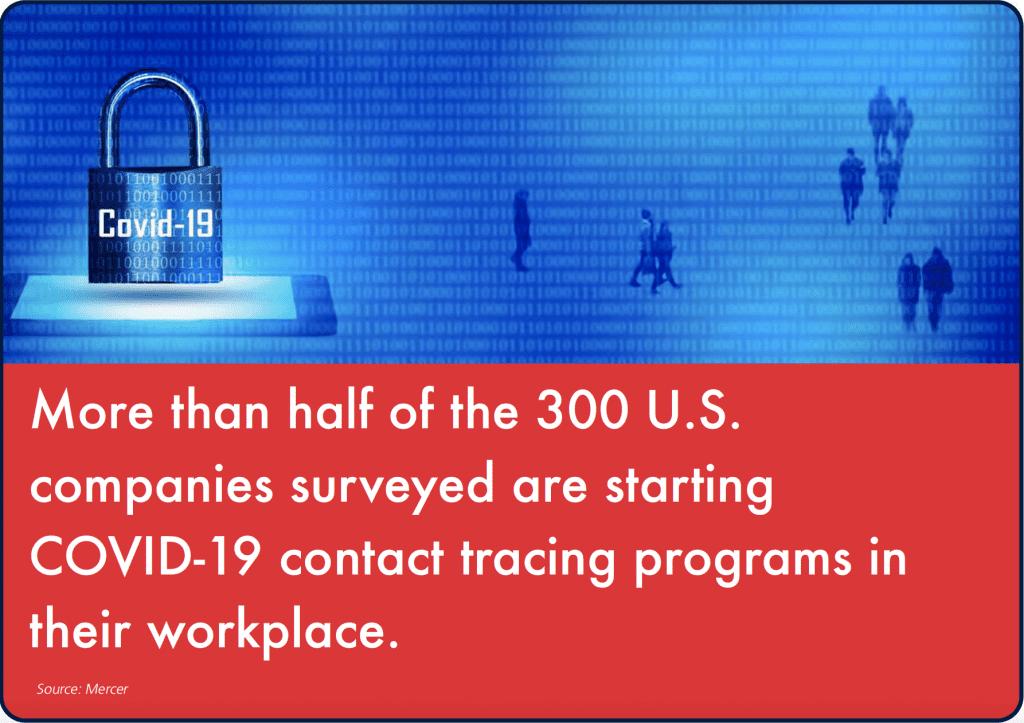Organizations are recognizing and responding to the critical importance of contact tracing in the age of COVID-19.
By Miguel Martinez
The concept of contact tracing -identifying those who may have come into contact with an infected person -has been around for some time now. Contact tracing is an essential tool for epidemiologists, public health experts, and medical professionals to manage and mitigate outbreaks of infectious diseases like Ebola and swine flu.
Contact tracing has been pivotal to combating the spread of coronavirus. In places like New Zealand, robust contact tracing programs have been implemented to great effect. In countries without a centralized federal contact tracing program -like the United States -initial contact tracing efforts have primarily been put in place by healthcare institutions, governmental entities, and nonprofit/voluntary services. Increasingly, there’s a new addition to that list. Private companies have recognized the value of implementing their own contact tracing programs.
Understanding how to build and maintain an effective in-house contact tracing program, including how to overcome common challenges and concerns, has quickly become an essential tool for any company looking to protect itself and its employees.
An Essential Tool
While contact tracing is primarily aimed at improving public health and safety and contributing to a deeper medical and scientific understanding of the spread of the coronavirus, private companies have other reasons to implement a program. Executive decision-makers are recognizing that contact tracing is a vital part of fulfilling their obligation to basic duty of care and compliance standards. Companies can also shield themselves from liability exposure by making sure they are taking reasonable measures to protect employee health and provide a safe working environment.
Companies need to have a reliable system in place to make sure employees are healthy and able to perform their functions for the sake of business continuity. Knowing when and for how long an employee is likely to be out -and what the extent of that disruption will be -allows time for planning and response. A program can help bring an inherently chaotic and unpredictable situation under control and allow companies to focus on making smarter and more informed business decisions.
Building a Program
Perhaps the first and most important element of any new contact tracing initiative begins well before the program itself is ever rolled out: clear and consistent communication to employees. Any contact tracing program is only as good as its participants, and buy-in from team members is critical. Be sure to shape perceptions and boost participation by communicating clearly and often both before and during the program’s rollout. Presenting contact tracing as what it is -a safety issue -and making it clear that it isn’t an unnecessary invasion of privacy can go a long way.
An experienced health and safety partner can be invaluable when it comes to building the operational details of the program itself, but keep in mind that every effective contact tracing program that protects employees and ensures organizational continuity includes the following elements:
- sufficient manpower to quickly conduct the tracing and communicate with potential exposures;
- uncompromising protocols to ensure that no exceptions are made and that all exposures and quarantine periods are observed; and
- infrastructure that will facilitate communication and collaboration with community leaders to enable tracing and eventually the delivery of vaccinations to the workforce and surrounding community.
Caveats and Complications
It’s important to note that CDC guidelines don’t allow employers to inquire about activities and contacts outside of the workplace. Private contact tracing must be limited strictly to employees and other employee contacts and potential exposures. The extent of those exposures can be significant, however, and the onset of cold and flu season will only make contact tracing efforts more challenging -and more pivotal. Any “COVID-like symptoms” must be treated seriously. For contact tracing purposes, organizations must assume everything is COVID-19 until the test is negative.
Another issue to consider when establishing contact tracing in a work environment is that a certain percentage of employees may be nervous, uncertain, reluctant, and or even hostile toward the program. Make sure employees understand in no uncertain terms that there is no job-related impact if they contract COVID-19, and that the program is solely designed to protect employees and keep the entire team as healthy as possible during a challenging global pandemic. Finally, recognize that the potential long-term liability implications of COVID-19 exposure are still unclear.
Comprehensive Solutions
The best security partners are proven providers of comprehensive contact tracing solutions. They are able to provide supplementary investigations support, crisis management expertise, and additional manpower as needed. They are security experts and advisors -not just call center personnel. A true security partner allows organizations to pivot, expand, or adapt the program if necessary, delivering a level of focus, flexibility, and efficiency that an in-house effort simply cannot offer. That flexibility is especially important given the relative newness and unpredictable nature of the coronavirus, and the speed with which circumstances can change in a region or an organization.
The right program should have robust technology to identify sick or symptomatic individuals and a system that triggers and initiates a contact tracing protocol. The right partner should also be able to handle any required reporting to public health entities for companies that do not have the capacity to handle that themselves.
The New Normal
Companies need to recognize that the quality of their internal messaging and communication is critical for the success of any contact tracing program. Many organizations understand that the implementation of a high-quality contact tracing program is the ideal moment to revisit their overall crisis management and business continuity plans. Some of the communication channels and monitoring/reporting infrastructure that gets put in place to handle contact tracing can and should be a part of crisis planning and emergency management protocols going forward.
Miguel Martinez is vice president of the global investigations unit for Pinkerton.















